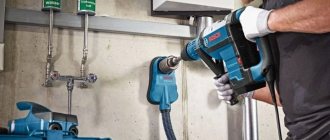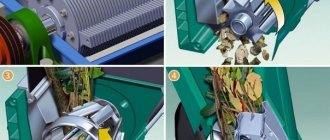It’s good when any garage, not to mention a workshop, has the necessary tools. But it is not always possible to buy it. Sometimes it's easier to do it yourself. For example, making a device such as a valve depressurizer yourself is more profitable than purchasing it.
We also recommend reading the article on how to make a homemade tilting stand for engine repair with your own hands. From this article you will learn about the requirements, manufacturing features and recommendations for such equipment for repairing internal combustion engines.
What is a cylinder head and valves How are they related
So, valves in a car are an element of the cylinder head (cylinder head). It is this part that is responsible for the processes of fuel combustion in the engine and the removal of exhaust gases (see figure).
Its components include:
- Cover to protect against mechanical damage.
- Rubber gasket that performs the sealing function. It is located in the place where the cover is attached.
- In the front part of the block there is a camshaft drive and a chain tensioner.
- Combustion chambers.
- Threaded holes for injectors and spark plugs.
- Holes for mounting inlet and outlet manifolds.
The top of the cylinder head also contains other parts, such as camshafts, backing washers, etc. The gas distribution mechanism (GRM) is also located here.
Non-removable parts of the cylinder head include valve seats, which serve to ensure the tightness of the timing belt. Fixed parts also include valve guides.
To avoid this, experts recommend that while driving you periodically pay attention to such points as:
- Presence of knocking noise while the engine is running.
- Stopping the engine when starting the car.
- Reducing compression in cylinders.
The presence of any of these symptoms may indicate a valve malfunction.
Of course, the best solution in such a situation is to contact a service center. However, a difficult financial situation or lack of time often does not allow resorting to the services of professionals. Then you can try to fix the problem yourself.
Installation Tips
Before installing the shafts, the piston of the first cylinder must be at the “top dead center”. To achieve this, rotate the crankshaft, grabbing it by the screw securing the generator pulley. Here you need a key “17”.
Alternator pulley and two timing shaft pulleys
The camshafts have spikes and the pulleys have grooves. Each pulley is equipped with a mark that should face up. The diagram shown in the photo corresponds to the upper position of piston 1. This is how the shafts are installed during installation.
You can set the crankshaft according to the mark located on the gearbox assembly (photo 1). This is done before installing the belt.
Various auxiliary elements
To set the tension correctly, use basic tips. Or you can do it simpler: when dismantling, note at what angle the tension roller was fixed. The key plate (photo 2) is set at the desired angle and the fixing nut is tightened (force 40 N*m).
How to screw the cylinder head
The threaded part of the screws is lubricated with engine oil. Then, maintaining a force of 20 N*m, the screws are tightened in the required order (see photo).
Recommended sequence (montage)
Second pass - each screw is turned at an angle of 90 degrees. On the third pass, the screws are turned another 90 degrees.
Chemistry
The bearing housing will be connected to the cylinder head cover. The connection itself must be airtight. A sealant is applied to the edge of the body around the perimeter: KLT-75M, Loctite-574, etc. During installation, the cylinder head gasket is not lubricated in principle - graphite or grease will only cause harm. Someone smears valve stems with graphite lubricant, which is also not correct. You need to use motor oil.
Before installation, the new valve is cleaned of factory grease. It is necessary!
Without desiccant
Tractor MTZ 82 Adjusting valves with cylinder head pulling
Without a valve depressurizer, they try to remove the crackers as follows. Take a pipe of a suitable diameter, install it on the spring mounting plate and hit the pipe with a hammer. When struck, the plate moves down, compresses the spring and releases the crackers, which fall onto the surface of the plate. After this, the spring unclenches and the crackers fly away in different directions. I cannot call this method of removing crackers other than barbaric.
This method may damage the valve, spring, or spring retainer. Loss of crackers is also possible. I'm not even talking about the fact that crackers can fall into the oil passages of the engine, and then you are guaranteed to completely disassemble the engine and search for the cracker in it.
What is a valve spring retainer?
The valve spring retainer is a small part that consists of two identical parts; if you put these parts together, you get a conical cylinder. On the inside of the crackers there are fastenings, with the help of which the cracker is attached to the valve stem. The valve stem must have grooves into which the fasteners for the cracker are inserted.
The valve spring is always compressed. Trying to unclench, she pushes the valve plate up. The valve plate compresses the nut around the valve stem. The cracker, which holds onto the grooves on the valve stem, prevents the plate from moving upward and thereby decompressing the valve spring. This is what secures the valve to the valve seat.
Valve desiccant
Checking and adjusting thermal clearances in the Renault Logan valve drive
When repairing a vehicle, a mechanic uses a large number of tools. And in some situations it becomes necessary to use such a special device as a valve depressurizer. Its main task is already clear from the name - to help a specialist remove the valve cotter.
What is a valve desiccant?
Therefore, first of all, we will understand what a cracker is, where exactly it is located on the valves and why its removal can only be done using a special tool.
So, as you know, the main task of the exhaust and intake valves is to tightly close the engine cylinder window, as well as to open it at the right time.
The implementation of this process is possible thanks to two return springs: they press on the plate, which in turn is connected to the rod using crackers. They, together with the force of the springs, hold the valve firmly in the seat when performing its main function.
These crackers look like a small cylinder divided into two halves. Inside its surface there is a spike that fits into the valve groove. The outer diameter of the crackers is larger than the inner diameter of the plate. Consequently, they are held very securely and strongly - so strongly that they can only be removed with a desiccant.
The first can be made from a metal pipe (its length should not exceed half a meter), with a diameter of one and a half to three centimeters, and the last two can be created according to the same pattern, only one should have a hole for attaching it to the head pin, and the second should have a persistent a washer with an internal diameter smaller than the valve plate, but larger than its internal hole.
How to dry valves correctly?
In fact, the technology for dismantling cracker cylinders is a simple task that any non-professional can handle. To do this, you just need to get a technological map and a desiccant.
So, in order to do desiccation, you will need to perform the following steps. First of all, you need to screw the desiccant bracket with the hole onto the head stud using a nut or screw it with a bolt.
And install the second bracket on the valve plate and apply gentle pressure on the end of the lever. Thus, moving down the valve, the plate will release the crackers, which are then carefully removed.
Next, after them, you can remove the spring and valve.
Video
How to remove crackers incorrectly?
Many people use pieces of pipe or a spark plug wrench to dismantle the crackers: one end of the pipe is placed on the valve plate, and the other is hit hard with a hammer. As a result of the impacts, the crackers are released from the plate, and they jump out of their seats.
However, sometimes sticking may occur during this process, which can result in a bent valve plate or valve stem. Therefore, if you don’t want to “run into” extra financial costs, don’t tempt fate - use a valve desiccant.
Why are there crackers in the engine?
Simple question: how to fix the valve in an internal combustion engine? The question ceases to be so simple if we remember that each valve - both inlet and exhaust - opens and closes with a frequency of 20-25, or even 40 times per second. Under such loads, the simple task of securing a valve becomes very difficult.
Is it possible to screw the valve to the spring with nuts? It is possible, but with constant shock and vibration, the nuts will tend to unwind, and even cotter pins will not give a reliable result. In addition, the threaded connection will be quite complex. It is also impossible to weld the valves “tightly” - in this case repair will be impossible.
That is why a special solution was found for fixing the valves - a crayon connection, which is as simple as it is reliable.
The structure of a crack joint generally comes down to the following. In the upper part of the valve stem (stem) there is an annular groove into which the inwardly directed annular projections of two crackers, shaped like a cylinder cut along the length, are inserted. When the cracks fit into the groove, a cylindrical thickening is formed at the top of the valve, which cannot move along the stem. The crackers rest against the plate that holds the springs and fix the valve in the closed position.
However, the crackers must be fixed so that they do not fall out due to constant vibration, but can still rotate freely in the groove. This is achieved very simply: there is a recess in the upper plate in which the crackers are located, as in a well, and cannot fall out provided that the valve springs do not weaken.
Types of desiccant agents and methods of their use
- Clamp type desiccant
Grinding in valves. How to lap valves. Valve grinding tool
The simplest and most reliable type of universal desiccant. Its only and most important drawback is that it can only be used on a removed cylinder head.
It is a large clamp, on one side of which there is a screw for pressing into the valve, and on the other side a screw with an annular stop for pressing on the valve plate.
To use this depressurizer, you need to install it coaxially on the valve and rotate the screw with an annular stop to compress the valve spring. After this, carefully remove the crackers using a small magnet. It's simple.
Attention! The following is a description of desiccants that can be used without removing the cylinder head. In this case, it is necessary to supply compressed air to the cylinder on which the valve desiccation operation is carried out.
Without compressed air, the valve will fall into the cylinder and you will have to remove the cylinder head.
- Lever type desiccant
Another universal desiccant. Its use does not require removal of the cylinder head. Its disadvantages include the inability to work with some motors due to limited adjustments.
It is a lever, at the end of which there is a plate with a cutout. An annular stop is installed at some distance from the end of the lever. A handle is installed at the other end of the lever for ease of operation.
To use this desiccant, you need to secure the plate to the cylinder head using a suitable bolt. Install the stop ring onto the valve disc. Press the handle with your hand, and carefully remove the crackers using a magnet with your other hand.
- Desiccant with hooks on the lower coils of the spring
A universal desiccant that allows you to work very quickly.
It is a complex device with hooks that are attached to the lower coils of the spring. Between the hooks there is a ring stop with an adjustment screw, which is driven by a handle located at the top of the device.
To use it, you need to secure the hooks to the lower coils of the spring. Use the adjustment screw to create a slight preload on the valve disc. Use your hand to press the handle of the derusting machine, and with your other hand, carefully remove the crackers using a magnet.
- Desiccant for engines with central spark plug wells
This type of desiccant is ideal for engines with centrally located spark plug wells. For the most part, such engines are used in BMW cars. The disadvantages of the desiccant include its high price and limited use.
It is a thick guide that is screwed into the spark plug well. The guide has a fitting for connecting the compressed air supply hose to the cylinder. A rocker arm is attached to the guide, on which a bolt with a pressure ring is attached.
To use it, you need to screw the guide into the spark plug well. Adjust the rocker arm and pressure ring bolt so that the ring is positioned above the valve plate. Use a bolt to apply a small amount of preload to the valve spring. Apply compressed air to the cylinder and dry out the valve. Simple and effective.
How to replace valves yourself
Replacing VAZ 2112 valves is carried out as follows:
- First of all, you need to remove all the removable parts of the cylinder head, and also disconnect the wires.
- Then the cylinder head cover is removed.
- Carbon deposits are removed from the cylinders. This can be done by putting a special brush on the drill.
- Next, the valves must be dried out and removed with tweezers. To do this, you need to tighten the spring.
- Diamond chips are applied to the edge of the valve.
- The valve comes back.
- The cylinder head is being assembled.
Point 5 presents a particular difficulty. It is worth dwelling on it in more detail. So, grinding is carried out as follows:
- Place the rubber tube onto the guide valve.
- Rotate the valve until a uniform pattern of diamond chips forms on its edge.
- Remove any remaining lapping paste.
Self-replacement of VAZ-2112 hydraulic compensators
A hydraulic compensator (or hydraulic pusher) is used to adjust thermal clearances in 16-valve engines.
Essentially, it is a “layer” between the camshaft and the valve, which adjusts its own thickness due to the plunger. That is, when the empty side of the distributor “fist” rotates, a space appears, which is compensated by raising the hydraulic pusher cylinder. In this case, the oil enters the compensator cavity itself. The reasons why hydraulic compensators may become faulty usually include wear and tear during operation, clogged oil channels, or plunger wear. In the last two cases, it is recommended to check the oil pump and the lubrication system as a whole for possible malfunctions. The main symptom of failure of the pushers is a typical knocking sound from the engine; an additional check - after removing the cover from the cylinder head - is that there is no resistance when pressed. It is better to replace hydraulic compensators comprehensively, since the reasons for the failure of one of them equally affect all the others. The cost of the kit for the VAZ-2112 is from two to three thousand rubles.
The replacement procedure itself is possible only after removing the cylinder head. After identifying the malfunction, you should remove the camshaft pulleys (if you have not already dismantled the entire block) and remove the oil pressure sensor. Next, the camshaft bearing housing is unscrewed (twenty bolts per piece) and the bracket securing the rod to the rear support is removed. Then the camshaft itself is removed, as well as the spark plug pipes and seals.
After identifying the malfunction, you should remove the camshaft pulleys (if you have not already dismantled the entire block) and remove the oil pressure sensor. Next, the camshaft bearing housing is unscrewed (twenty bolts per piece) and the bracket securing the rod to the rear support is removed. Then the camshaft itself is removed, as well as the spark plug pipes and seals.
After dismantling the plugs, you can remove the defective hydraulic compensators using a magnet. Then new ones are installed, and after cleaning and lubricating the cylinders and bearings, the block is assembled (in reverse order).
Necessary parts and tools for repair
Troubleshooting the cylinder head begins with the purchase of original parts and various consumables, the list of which is as follows:
- Fuel intake system valve 8 pcs. (art. 21120-1007010).
- Exhaust gas valve 8 pcs. (art. 21120-1007012).
- Set of hydraulic compensators 16 pcs. (art. 21120-1007300).
- Gaskets for valve cover, cylinder head, intake manifold, exhaust manifold (all come as a set art. 21120-1002064-86).
- Bolts securing the cylinder head to the engine crankcase (art. 21120-1003271-018).
- Timing belt (art. 2112-1006040-02RU), timing tension roller (art. KT100507/100513), drive belt for mounted units (art. BP638).
- Engine oil and oil filter.
- Cooling system fluid.
Installation of valves on a VAZ 2112 is carried out using a standard set of tools, as well as several specialized types of keys:
- standard set of spanners from 8 to 24 mm;
- socket sockets in a set from 8 to 27 mm;
- end internal hexagons;
- mechanical valve retaining ring remover (depressurizer);
- torque wrench for tightening the cylinder head and camshaft bolts;
- paste for grinding valves (set for rough and fine grinding);
- metalworking cloth gloves to protect hands while working.
The work of replacing 16 valves on a VAZ 2112, the price of which as of this fall is about 50 thousand rubles at AvtoVAZ dealerships (or approximately 35-40 thousand rubles at ordinary car repair shops), is not a very complicated process. You can carry out the work yourself, for which it is enough to purchase the above-described spare parts and the necessary tools.
How to dry valves correctly?
In fact, the technology for dismantling cracker cylinders is a simple task that any non-professional can handle. To do this, you just need to get a technological map and a desiccant.
1ou Blog How to dry out the cylinder head valves of a VAZ 2112 16 cl.
How to dry valves 16 cl. VAZ engines quickly and efficiently? what equipment is needed? There is such a method and equipment
You need a screw type desiccant that looks something like this:
The head of the desiccant presented above is homemade; the old head is removed by cutting and drilling out the rivets.
The new one is made from a piece of VPG pipe (VodoprovodnoGazovaya) DU (conditional diameter or nominal bore) 20. VPG pipe DU 20 is about 26.8 mm in diameter. Sold at any decent hardware store. Fits.
Using a grinder and a welder we make the following design:
How to dry - step by step.
1. Take comfortable curved tweezers.
What you need to make your own desiccant
To make this device, you will first need suitable materials. For the clamp option you need to have:
- Metal profile or sheet metal 10-15 mm thick;
- A couple of large bolts or studs (screws will be made from them, so the length of each is at least 15 cm);
- Two nuts comparable to the bolts.
For the lever option, you must stock up on the following elements in advance:
- A metal pipe or rod with a diameter of about 15 mm and a length of up to 40-50 cm;
- Two steel strips 20-30 mm wide and 5 cm long. Thickness about 3 mm.
- Two strips 20-30 mm wide, up to 3 mm thick, 15 cm long;
- Two 6x25 mm bolts with nuts and washers;
- Two steel washers (you can make your own). The first has a diameter of 25 mm, a thickness of about 3 mm, and an internal hole of 8 mm. The second has a diameter slightly larger than the spring plates. Its thickness is at least 5 mm.
Of course, it will not be possible to make a valve desiccant without available tools. Required:
- Grinder or hacksaw for metal;
- Welding machine (you will have to make several seams of 2-3 cm each);
- Vise;
- Drill and drill bits for metal;
- Spanners.
Other cases in which dismantling of the cylinder head is required
Of course, it is not necessary to remove the cylinder head for every breakdown. This is only necessary if major repairs are needed. Such “major” cases include:
- Gasket wear.
- Formation of carbon deposits on parts.
- Valve deformation.
- Need to replace guide bushings.
- Failure of the camshaft, etc.
Of course, repairing it yourself or through a service in any case involves certain financial costs. To ensure smooth operation of the engine, regular diagnostics of the cylinder head are necessary. It is recommended to use high-quality fuel. In addition, try to prevent the car from overheating - because of this, the cylinder head may lead.
If some points remain unclear to you, then you can visually familiarize yourself with the process of replacing valves by watching the video:
Tool for replacing oil seals.
So, before approaching the car, prepare everything you need:
- cap remover - if you don’t have one, you can do without it;
- valve desiccant;
- long-nose pliers or tweezers;
- new valve stem seals in the required quantity (equal to the number of valves in the engine), possibly with a small margin;
- magnetic pointer;
- valve cover gasket;
- tin rod;
- flat screwdriver.
When you have all this in your hands, you can proceed directly to the repair work.
Advantages of a 16-valve engine
The VAZ 2112 with 16 engine valves has a number of advantages over cars of the same brand, but with fewer valves. Its main advantage is the ability to achieve maximum engine power, regardless of the type of the latter. (see picture).
- VAZ 2112 with a volume of 1500 cubic cm, has 77 horsepower.
- A VAZ 2112 of the same volume can have a power of up to 90 horsepower.
This difference is possible due to the fact that in the second case the filling of the cylinders with the warm-air mixture is much higher.
In addition, the advantages of the 16-valve engine:
Better performance of the cooling system and, as a result, greater strength of the unit. Possibility of increasing engine knock resistance
This is especially important if low quality fuel is used. With 16 valves, the intake and exhaust tracts are located on opposite sides of the cylinder head, which facilitates their installation, repair, etc.
Making a valve desiccant with your own hands, description, diagrams
Every motorist sooner or later faces the need to repair his car. Some people prefer to entrust this work to a car service, while others like to repair their car themselves. But not every breakdown can be eliminated without the help of special devices. Therefore, if it is necessary to disassemble or assemble the gas distribution mechanism, car enthusiasts are interested in how to make a valve depressurizer with their own hands. The desiccant will help greatly facilitate the repair of the cylinder head, or will be useful when replacing valve stem seals. With its help, you can easily press the spring to remove the crackers. Of course, a device for desiccating valves can be purchased at a car dealership, but it is often much more convenient to make it yourself. In this case, it will fully meet your requirements.
There are two types of devices for desiccation of valves, which are fundamentally different from each other:
- The lever desiccant is a universal device. It can be used both with the head removed and without dismantling it (for example, when changing oil scrapers). A significant disadvantage is the need for pair work - while one person presses the spring, the other needs to get the crackers. Making this tool is not as difficult as it might seem at first glance.
- A screw desiccant is more convenient to use, as it allows you to work alone. The disadvantages of such a tool include the need to dismantle the head and select it for a specific model of the unit. And making this type of valve desiccant with your own hands is more difficult.
Universal desiccant diagram
You can assemble a universal valve desiccant with your own hands using simple drawings. It is based on a lever with two brackets attached to it. These brackets are attached using screws and nuts to form a hinge joint. To assemble it you need to prepare:
- Bulgarian;
- Welding machine;
- Durable metal bar for lever;
- Two short strips for making brackets (one is approximately half as long as the other);
- A pipe with a diameter slightly larger than the plate covering the springs and approximately 3-5 cm long.
Weld a washer with a diameter of approximately 8 mm to the shortest strip. It will be used to attach the device to the unit. Its other end is attached to the edge of the lever using a hinge method. A prepared piece of pipe is welded to the middle bar, and also attached to the lever, only closer to its center. To put the structure into action, you need to attach the short bracket to the edge of the head, and install the middle part with the pipe on the plate. Pressing the handle of the structure allows you to press the spring down, freeing access to the crackers.
It can be made using available materials. Since the model has a clamp structure, it is more convenient to create a desiccant based on it. To make a homemade screw valve depressurizer, we will prepare the following materials:
- Bulgarian;
- Welding machine;
- 2 extended nuts;
- 2 long bolts;
- A piece of pipe, 3-5 cm long, and slightly larger in diameter than a plate;
- A washer with a diameter suitable for the pipe.
Desiccant on a clamp
We cut out the workpiece from the profile so that we can weld the part in the shape of a bracket. The length of the main workpiece is 250 mm, the side pieces are 150 mm. We weld the power frame. For clamps we use extended nuts and long bolts. The nuts are welded to the steel profile, and bolts are inserted into them towards the center of the structure. A piece of iron pipe, approximately 3-5 cm long, is welded onto one of the bolts. Pre-weld one hole in the pipe with a washer of a suitable diameter. Use it to attach (or weld) the tube to the bolt. For use, the desiccant is installed on the block head as follows: a piece of pipe is installed on the spring plate, and with the help of a second bolt this spring is displaced (compressed). After this, crackers are taken out. It's easier to do this with tweezers.
As you can see, making a device for desiccating valves with your own hands is not at all difficult. You will need simple materials and a little time spent to comfortably carry out repairs on your favorite car.
Manufacturing of screw desiccant
- Making a frame bracket. This is the main part of this type of desiccant. It can be cut from a single sheet of metal, but it will be much more convenient to weld it from several pieces of profile or thick steel strips. The dimensions depend on the specific car model, but the average internal indicators are as follows: length of at least 210 mm, width of at least 150. The result is a frame in the form of a large printed letter C.
- After the bracket is ready, nuts are welded onto the ends of the short sections.
- A piece of pipe is also welded to one of the bolts. Either a large washer or a valve plate is welded to the second one - this will be a support.
- The bolts are screwed into the welded nuts so that when screwed they move towards each other and towards the center of the bracket.
Principle of use
The first step is to carefully place the outer bracket of the desiccant onto the pin. Only in this case will it be possible to hold the bed in order to screw the nut onto it. A shaped washer is installed on a plate, which not only covers the springs, but also presses the lever. The outer side of two crackers is presented in the form of a small cone. In some cases, with slight pressure on the plate, it may become motionless on the valve stem. In such a situation, you need to hit it a little from above in the middle of the lever with a regular hammer. Only when the springs are compressed can the crackers be removed from the nest.
Do-it-yourself universal valve desiccant
The question of where to get a valve sealer arises before a car enthusiast after he decides to repair the cylinder head or change the valve stem seals with his own hands. It is not possible to make such repairs without this device.
A valve depressurizer is needed to compress the valve springs during disassembly, as well as during subsequent assembly of the gas distribution mechanism.
There are two types of desiccants:
- For operation only on a dismantled head.
- Universal. Allows you to work both without removing the head and after its dismantling.
A valve depressurizer for repairing a removed head resembles a clamp for compressing thick parts, which, with its stops, presses on one side the plate covering the springs, and on the other side on the valve. This tool, of course, is much more convenient than a universal desiccant, since after compressing the springs it leaves your hands free and does not interfere with removing the crackers from the socket. But you can only use it when the head is removed, and you wouldn’t remove the head of the block just to change the valve stem seals. Therefore, car enthusiasts usually make do with a universal one.
Such a device consists of a lever and two brackets, hinged to it using screws and nuts or rivets. The bracket located on the edge of the lever serves to secure the device to the head. It most often ends in a thick steel washer with a hole about 8 mm in diameter. To bring the desiccant into working condition, it is put on the camshaft bed mounting stud and secured with a nut. The bracket, located in the middle of the lever, ends with a washer with a diameter slightly larger than the plate of the covering spring and serves to press on it.
If you have the desire and the necessary tools, you can easily make this device yourself. Here is a list of tools needed to make it:
- Hacksaw for metal.
- Drill with drills.
- Semi-automatic welding.
It doesn’t matter if you don’t have a semi-automatic machine, since in this design you only need to make four welding seams, each 1 cm long.
To make this device with your own hands, you need to stock up on the following materials and fasteners:
- A piece of steel pipe with a diameter of about 1.5 cm - 40 cm.
- Screws M 6×25–2 pcs. and nuts for them (also 2 pieces).
- Steel strips 1×5 cm, 3 mm thick – 2 pcs.
- Steel strips 1×15 cm, 3 mm thick – 2 pcs.
- 2 steel washers. One is 2.5 cm in diameter, 3 mm thick with a Ø 8 mm hole in the middle, but the other, unless you are a turner, cannot be made with your own hands. The diameter of the second washer should be 0.6 cm larger than the diameter of the spring plate, and its thickness should be 5 mm. On its working side, a recess should be made 2–3 mm deep with a diameter equal to the outer diameter of the plate. And in the middle make a hole slightly smaller than the recess.
In order to begin assembling the device, you need to make brackets from washers and steel strips. To do this, place the thrust washer with the recess down, and place steel strips diametrically opposite to its edges and weld them. The second knot is made in the same way, the only difference is that the washer is placed arbitrarily. After the welding has cooled, you need to drill a Ø 6.5 mm hole in each strip. They should be located at a distance of 0.3–0.4 cm from the unwelded edges.
After this, use the same drill to drill two holes in the pipe section. One of them is half a centimeter from the edge, the other is in the middle. Now we can assemble our device. Using screws and nuts, attach a bracket with a flat washer to the edge of the lever and another in the middle. After completing the installation, the device is ready for use.
After removing the camshaft, place the outer bracket on the stud that held the bed and screw the nut onto it. Place the shaped washer of the other bracket on the plate covering the valve springs and press the lever with your hand. The outer surface of two crackers folded together is a truncated cone, just like the seat for them in the plate. Therefore, sometimes the plate, when pressed, is held by crackers on the valve stem. In this case, you need to lightly hit the middle of the lever from above with a hammer. When the springs are compressed and the plate moves down the valve stem, use your free hand to take tweezers and use them to remove the crackers from the socket. Remove both springs along with the other parts from the rod and move the device to the next stud.
Features of dismantling
Dismantling includes such actions as:
- Place a soft stop under the valve.
- Pressing on the plate.
- Removing the crackers with tweezers (a screwdriver with a magnet will also work).
- Moving the plate up. It is important to do everything carefully so that the spring does not bounce off.
Sometimes when pressing on a plate you need to use a striking force, that is, a hammer. There are also special tools. For example, a puller works like a vice.
How to remove crackers incorrectly?
Many people use pieces of pipe or a spark plug wrench to dismantle the crackers: one end of the pipe is placed on the valve plate, and the other is hit hard with a hammer. As a result of the impacts, the crackers are released from the plate, and they jump out of their seats.
However, sometimes sticking may occur during this process, which can result in a bent valve plate or valve stem. Therefore, if you don’t want to “run into” extra financial costs, don’t tempt fate - use a valve desiccant.
Sources
- https://xn--29-6kcd5bg.xn--p1ai/populyarnye-stati/kak-rassuharit-klapana-bez-rassuharivatelya.html
- https://prometey96.ru/lada-remont/rassuharivatel-klapanov-vaz-2112-16.html
- https://PechaleAvto.ru/drugoe/rassuharivatel-vaz-2112-16-klapanov.html
- https://prometey96.ru/ustrojstvo/kak-legko-zasuharit-klapana.html
- https://7gear.ru/avtomobili/kak-rassuharit-klapana-bez-rassuharivatela.html
- https://avto-lover.ru/drugoe/kak-legko-zasuharit-klapana-2.html











